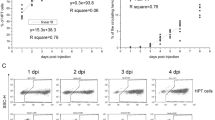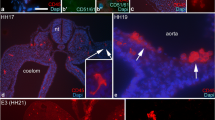Abstract
Cell-mediated responses of the moth immune system involve the interaction of two main classes of hemocytes—granular cells and plasmatocytes. During embryogenesis, granular cells arise much earlier than plasmatocytes, and the presence of granular cells is closely coupled with the formation of basal laminae that line the hemocoel occupied by hemocytes. Although epithelial cells contribute the large extracellular matrix protein lacunin to embryonic matrices before granular cells begin contributing this protein to basal laminae, the spatial pattern of lacunin expression in early embryos parallels the later distribution of granular cells over surfaces of basal laminae. Plasmatocytes arise late in embryogenesis, after the cessation of the major morphogenetic movements and the establishment of intact basal laminae. Granular cells are intimately involved with remodeling of basal laminae, and disruptions in the structure of basal laminae can trigger an autoimmune response of granular cells and plasmatocytes. By arising after basal laminae have been molded and remodeled by granular cells, plasmatocytes presumably do not encounter the cues that trigger their aggregation and an autoimmune response.






Similar content being viewed by others
References
Akai H, Sato S (1971) An ultrastructural study of the haemopoietic organs of the silkworm, Bombyx mori. J Insect Physiol 17:1665–1676
Asgari S, Theopold U, Wellby C, Schmidt O (1998) A protein with protective properties against the cellular defense reactions in insects. Proc Natl Acad Sci USA 95:3690–3695
Broadie KS, Bate M, Tublitz NJ (1991) Quantitative staging of embryonic development of the tobacco hawkmoth, Manduca sexta. Roux’s Arch Dev Biol 199:327–334
Copenhaver PF, Taghert PH (1989) Development of the enteric nervous system in the moth. I. Diversity of cell types and the embryonic expression of FMRFamide-related neuropeptides. Dev Biol 131:70–84
Dorn A, Bishoff ST, Gilbert LI (1987) An incremental analysis of the embryonic development of the tobacco hornworm, Manduca sexta. Int J Invertebr Reprod Dev 11:137–158
Fessler LI, Nelson RE, Fessler JH (1994) Extracellular matrix of Drosophila. Methods Enzymol 245:271–294
Gardiner EMM, Strand MR (1999) Monoclonal antibodies bind distinct classes of hemocytes in the moth Pseudoplusia includens. J Insect Physiol 45:113–126
Gardiner EMM, Strand MR (2000) Hematopoiesis in larval Pseudoplusia includens and Spodoptera frugiperda. Arch Insect Biochem Physiol 43:147–164
Giancotti FG, Ruoslahti E (1999) Integrin signaling. Science 285:1028–1032
Hinks CF, Arnold JW (1977) Haemopoiesis in Lepidoptera. II. The role of hematopoietic organs. Can J Zool 55:1740–1755
Kiger JA, Natzle JE, Green MM (2001) Hemocytes are essential for wing maturation in Drosophila melanogaster. Proc Natl Acad Sci USA 98:10190–10195
Kramerova IA, Kramerov AA, Fessler JH (2003) Alternative splicing of papilin and the diversity of Drosophila extracellular matrix during embryonic morphogenesis. Dev Dyn 226:634–642
Lanot R, Zachary D, Holder F, Meister M (2001) Postembryonic hematopoiesis in Drosophila. Dev Biol 230:243–257
Lebestky T, Chang T, Hartenstein V, Banerjee U (2000) Specification of Drosophila hematopoietic lineage by conserved transcription factors. Science 288:146–149
Loret SM, Strand MR (1998) Follow-up of protein release from Pseudoplusia includens hemocytes: a first step toward identification of factors mediating encapsulation in insects. Eur J Cell Biol 76:146–155
Mori H (1979) Embryonic hemocytes: origin and development. In: Gupta AP (ed) Insect hemocytes. Cambridge University Press, Cambridge, pp 4–27
Murray MA, Fessler LI, Palka J (1995) Changing distributions of extracellular matrix components during early wing morphogenesis in Drosophila. Dev Biol 168:150–165
Nardi JB, Miklasz SD (1989) Hemocytes contribute to both the formation and breakdown of the basal lamina in developing wings of Manduca sexta. Tissue Cell 21:559–567
Nardi JB, Hardt, TA, Magee-Adams SM, Osterbur DL (1985) Morphogenesis in wing imaginal discs: its relationship to changes in the extracellular matrix. Tissue Cell 17:473–490
Nardi JB, Martos R, Walden KKO, Lampe DJ, Robertson HM (1999) Expression of lacunin, a large multidomain extracellular matrix protein, accompanies morphogenesis of epithelial monolayers in Manduca sexta. Insect Biochem Mol Biol 29:883–897
Nardi JB, Gao C, Kanost MR (2001) The extracellular matrix protein lacunin is expressed by a subset of hemocytes involved in basal lamina morphogenesis. J Insect Physiol 47:997–1006
Nardi JB, Pilas B, Ujhelyi E, Garsha K, Kanost MR (2003) Hematopoietic organs of Manduca sexta and hemocyte lineages. Dev Genes Evol 213:477–491
Pech LL, Strand MR (1995) Encapsulation of foreign targets by hemocytes of the moth Pseudoplusia includens (Lepidoptera; Noctuidae) involves an RGD-dependent mechanism. J Insect Physiol 41:481–488
Pech LL, Strand MR (1996) Granular cells are required for encapsulation of foreign targets by insect haemocytes. J Cell Sci 109:2053–2060
Rizki RM, Rizki TM (1980a) Developmental analysis of a temperature-sensitive melanotic tumor mutant in Drosophila melanogaster. Roux’s Arch Dev Biol 189:197–206
Rizki RM, Rizki TM (1980b) Hemocyte responses to implanted tissues in Drosophila melanogaster larvae. Roux’s Arch Dev Biol 189:207–213
Rizki TM, Rizki RM (1984) The cellular defense system of Drosophila melanogaster. In: King RC, Akai H (eds) Insect ultrastructure, vol 2. Plenum, New York, pp 579–604
Rugendorff A, Younossi-Hartenstein A, Hartenstein V (1994) Embryonic origin and differentiation of the Drosophila heart. Roux’s Arch Dev Biol 203:266–280
Schmit AR, Ratcliffe NA (1977) The encapsulation of foreign tissue implants in Galleria mellonella larvae. J Insect Physiol 23:175–184
Strand MR, Pech LL (1995) Immunological basis for compatibility in parasitoid-host relationships. Annu Rev Entomol 40:31–56
Tepass U, Fessler LI, Aziz A, Hartenstein V (1994) Embryonic origin of hemocytes and their relationship to cell death in Drosophila. Development 120:1829–1837
Tolbert LP, Hidebrand JG (1981) Organization and synaptic ultrastructure of glomeruli in the antennal lobes of the moth Manduca sexta: a study using thin sections and freeze-fracture. Proc R Soc Lond B 213:279–301
Wiegand C, Levin D, Gillespie JP, Willott E, Kanost MR, Trenczek T (2000) Monoclonal antibody MS13 identifies a plasmatocyte membrane protein and inhibits encapsulation and spreading reactions of Manduca sexta hemocytes. Arch Insect Biochem Physiol 45:95–108
Wieschaus E, Nüsslein-Volhard C (1998) Looking at embryos. In: Roberts DB (ed) Drosophila: a practical approach. Oxford University Press, Oxford, pp 199–228
Wigglesworth VB (1937) Wound healing in an insect Rhodnius prolixus (Hemiptera). J Exp Biol 14:364–381
Acknowledgements
The electron micrographs and confocal images were prepared by Lou Ann Miller at the Center for Microscopy and Imaging, College of Veterinary Medicine at the University of Illinois. She meticulously and skillfully prepared all final images for this publication. Scott Siechen of the Department of Cell and Structural Biology provided information on comparative staging of Drosophila embryos. Stephanie Shockey carefully prepared the final version of this manuscript. This work was supported by a grant from the National Institutes of Health (1 R01 HL 64657).
Author information
Authors and Affiliations
Corresponding author
Additional information
Edited by P. Simpson
Rights and permissions
About this article
Cite this article
Nardi, J.B. Embryonic origins of the two main classes of hemocytes—granular cells and plasmatocytes—in Manduca sexta . Dev Genes Evol 214, 19–28 (2004). https://doi.org/10.1007/s00427-003-0371-3
Received:
Accepted:
Published:
Issue Date:
DOI: https://doi.org/10.1007/s00427-003-0371-3




